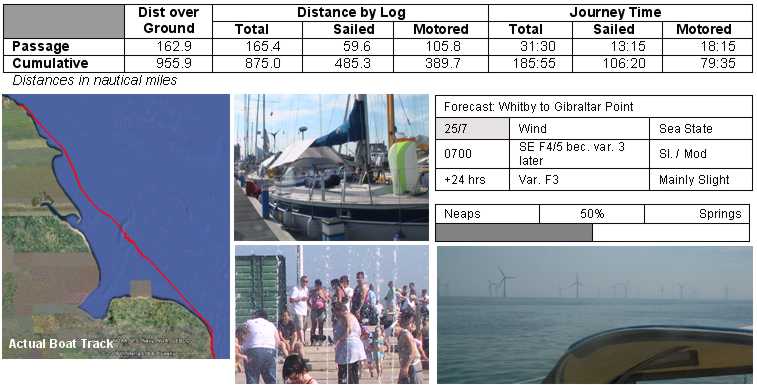

|
When originally planning the trip we had thought that we would possibly go to Grimsby from Whitby and then on to Lowestoft. However the tides were such that if we left Whitby under the first bridge opening of the day (0715) our ETA at Grimsby would be 2230 and although this worked in terms of tidal access, the following day we would have a 19hr trip to Lowestoft which was not overly appealing. Wells-next-the-Sea had been ruled out as the tidal restrictions didn't really work for us and bearing in mind our Amble experience we wanted to ensure we didn't get stuck again so soon. We therefore opted for the longer but more direct trip to Lowestoft.
We would be leaving with a fair tide, which was favourable from HW Dover +2hrs (0600) and would be with us until we were well passed Flamborough Head, where our route would take us 2½ miles offshore. From there we would pass to the seaward side of the New Sand Hole TSS and anchorage area at its outer end leaving the Outer Sand ECM a mile or so to starboard then continuing on to the East of Dudgeon Shoal and thereafter to follow Caister Road, Yarmouth Road, Gorleston Road (staying inshore of the main channel), Corton Road and finally Lowestoft North Road down to Lowestoft Ness.
This passage was very different for us as we weren't used to looking at a chart and seeing single digit depths so far offshore, being far more used to the depth gauge maxing out! We also expected the shipping traffic to be considerably more than we had experienced before and being shorthanded with the forecast wind on our bow we knew that it would be a tiring night.
Given the length of the passage and lack of any gates, tides weren't a primary consideration for the purpose of planning this leg other than leaving Whitby through the first bridge opening, which would in any case give us a fair tide to well past Flamborough Head and also again as we moved into the stronger tidal flows off The Would. Alternative refuges were few; however we had Filey as an anchorage in a real push and could shorten to either Grimsby or Wells if required.
On leaving Whitby there was a fairly big sea running and with no wind we motored to Flamborough Head keeping 2½M offshore. The sea did calm down slightly once we were passed Flamborough Head. The wind picked up and we were able to get the engine off for 6 hours or so while still maintaining reasonable progress. The SE wind and adverse tide (although not strong) pushed us further inshore than we would have liked so we motor sailed again to get back on track. Other than avoiding the shipping there were no passage issues and as the seas moderated slightly we'd made sufficient progress to get the engine off and sail through the night which is always far more pleasant for the kids below. However the wind died again at around 0330 so it was back on with the engine.
After dawn the mist closed in and with a radar failure (the belt drive in the radome had come of its spindle) an extra close watch was maintained. The wind filled in and shifted the mist at around noon when we reached Cockle Gatway. From there the tides were strongly in our favour (running at 2kts or so) so progress was swift down to Lowestoft. The channels are well marked and there's plenty of depth to keep well clear of shipping.
It had been a good trip although the wind necessitated far more motoring than we would have liked.
On arrival at Lowestoft the tide was setting across the harbour entrance but width is fine so no issues. After obtaining permission to enter the harbour we contacted RN&SYC and were instructed to go wherever there was space. It was a busy visitors' pontoon and was soon rafted 3 deep along its length.
The Yacht Club is great, with good facilities and food and Lowestoft was a terrific place to provide some shore entertainment after a long passage for the kids. The pontoons are serviced although the water is marked as not for drinking. We paid £20 a night for our berth.